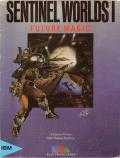Sentinel Worlds I: Future Magic
| Sentinel Worlds I: Future Magic | |
|---|---|
 | |
| Developer(s) | Binary Systems, Electronic Arts |
| Publisher(s) | Electronic Arts |
| Designer(s) | Karl Buiter |
| Platform(s) | DOS, Commodore 64 |
| Release date(s) | 1989 |
| Genre(s) | Role-playing video game/Strategy |
| Mode(s) | Single player |
| Distribution | Floppy Disk |
Sentinel Worlds I: Future Magic is a 1989 sci-fi role-playing video game. It was programmed by Karl Buiter and published by Electronic Arts.[1] It was developed for the Commodore 64 and DOS.
Set in the year 2995, Sentinel Worlds I: Future Magic was an innovative game that allowed a player to command a crew of five Federation officers and embark on an epic quest to save the Caldorre System from space raiders. Your mission is to develop your crew and a starship and find the raiders' base and rid the system of them. The game was particularly notable for a musical score that simulated multiple instruments by swapping between them faster than the human ear could differentiate.
Gameplay
Sentinel Worlds I: Future Magic was a compelling video game combining both the elements of Starflight and The Bard's Tale, and had some innovations which set it apart from other games at the time. It was one of the pioneers in the budding sci-fi RPG genre.[2]
The game was non-linear and allowed players to ignore the entire plot and explore space for as long as they wanted. It also mixed elements of an RPG with a space-shooter, requiring both strategy and tactics as the player would have to dog fight enemy vessels. Players could also choose to venture into trading by mining and harvesting resources on other planets. Much of the game also took the players onto the ground, where they could fight ground battles using a wire-frame 3D display of their environment and engage in conversation, combat, or trade.
The main component of the game starts out in the dog fighting space combat scenario, fighting to protect merchant shipping. As the story progresses, other elements of the game, including exploration, trade, conversation, ship boarding, ground combat and investigation are brought into the mix. Players must balance their resources and cash with repairs from battle, buying new weapons and armor, and upgrading their vessel.
Plot
Setting
At the start of the game, the players are sent as part of a task force to combat a group of mysterious space raiders in the Caldorre system, who appear from nowhere to ravage merchant shipping in the area. Earlier efforts with battleships were ineffective against the light, agile raiders, so smaller Interceptor-class vessels with specially trained crews were dispatched to counter the threat and eventually end it. The Caldorre system has only three worlds—Caldorre itself, inhabited by a technologically advanced culture that dwells in huge towers on the planet's surface and service passing ships; Norjaenn, a frontier like world embroiled in a bitter war between rancher types and settler farmers over limited land space, and Ceyjavik, an icy world that is home to many exotic arctic animals and a small research station.
Reception
Scorpia in Computer Gaming World had mixed feelings about the game. She described the graphics, especially during takeoff and landing, as "the most exceptional use of EGA graphics I've seen yet in an adventure game", but criticized the slow movement speed both indoors and out, as well as the fact that only the team leader could be directly controlled, with the computer controlling the remainder of the team, sometimes poorly.[3] In a later issue, Scorpia wrote "Several have written to me, asking if there is more to the game than shooting down raider ships. There certainly is, but it will take awhile before the "real" action starts."[4] Orson Scott Card was more positive, writing in Compute! that "no other game ... matches Sentinel Worlds for sheer depth". He praised the graphics and writing, which he compared to the "embarrassingly bad writing in the Ultima series".[5]
See also
- Hard Nova also by Karl Buiter and considered a quasi-sequel
- Starflight
- Star Control 2
- Elite (1984)
- Iron Seed (1994)
References
- ↑ Barton, Matt (2007-02-23). "Part 2: The Golden Age (1985-1993)". The History of Computer Role-Playing Games. Gamasutra. Retrieved 2009-03-26.
- ↑ "Remarkable New Computer Games Are Here Just in Time for Christmas". Atlanta News. 1989. Retrieved 2009-02-24.
- ↑ Scorpia (Dec 1988). "Magical, Mystery Future". Computer Gaming World. pp. 36–37, 53.
- ↑ Scorpia (Feb 1989). "Scorpion's Mail". Computer Gaming World. pp. 21, 24.
- ↑ Card, Orson Scott (June 1989). "Light-years and Lasers / Science Fiction Inside Your Computer". Compute!. p. 29. Retrieved 11 November 2013.
Trivia
"Inside a battle helmet, no one can hear you scream." (catch phrase on the game's magazine advertisement).